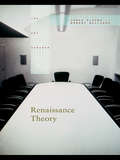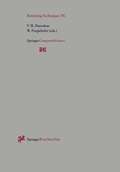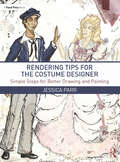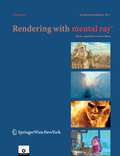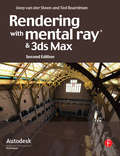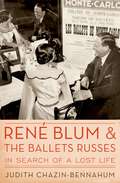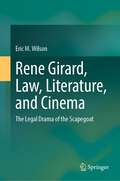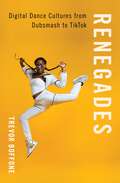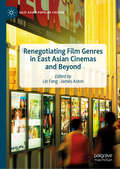- Table View
- List View
Renaissance Theory (The Art Seminar)
by James Elkins Robert WilliamsRenaissance Theory presents an animated conversation among art historians about the optimal ways of conceptualizing Renaissance art, and the links between Renaissance art and contemporary art and theory. This is the first discussion of its kind, involving not only questions within Renaissance scholarship, but issues of concern to art historians and critics in all fields. Organized as a virtual roundtable discussion, the contributors discuss rifts and disagreements about how to understand the Renaissance and debate the principal texts and authors of the last thirty years who have sought to reconceptualize the period. They then turn to the issue of the relation between modern art and the Renaissance: Why do modern art historians and critics so seldom refer to the Renaissance? Is the Renaissance our indispensable heritage, or are we cut off from it by the revolution of modernism? The volume includes an introduction by Rebecca Zorach and two final, synoptic essays, as well as contributions from some of the most prominent thinkers on Renaissance art including Stephen Campbell, Michael Cole, Frederika Jakobs, Claire Farago, and Matt Kavaler.
Rendering in SketchUp: From Modeling to Presentation for Architecture, Landscape Architecture, and Interior Design
by Daniel TalThe sure way for design professionals to learn SketchUp modeling and rendering techniques Rendering In SketchUp provides instructions for creating 3D photoreal graphics for SketchUp models using integrated rendering programs. The book serves as a beginner rendering manual and reference guide to further develop rendering skills. With an emphasis on step-by-step process, SketchUp users learn a universal approach to rendering varied SketchUp projects, including architecture, interiors, and site design models. The book focuses on tasks and principles at the core of photorealistic rendering, including: Rendering process: Learn a step-by-step process focused on workflow within SketchUp’s familiar workspace. Universal method: Understand how the process can be used to work with a variety of different integrated rendering programs, including Shaderlight, SU Podium and Twilight Render**. These programs are easy to learn and function in SketchUp. // // > Textures and materials: Discover how to obtain, apply and edit texture images representing surfaces. Component details: Learn how to acquire and organize model details to allow for rich, expressive settings while maintaining computer and SketchUp performance. Exterior and simulated lighting: Learn to set exterior lighting with the SketchUp’s Shadow menu or illuminate a scene with simulated lights, lamps, and bulbs. Render settings: Use specific settings for various rendering programs to quickly set texture character, image quality, and graphic output. Computer specifications: Find out how computers produce renders and the type of computer hardware required to streamline the process. Photoshop post-processing: Learn how to further refine rendered images in Photoshop. **Free online chapters: The book reviews specific settings for SketchUp and the rendering plug-in Shaderlight. Given the ever-changing nature of technology, free, online accompanying chapters detail settings for additional integrated rendering programs including SU Podium, Twilight Render, and more.
Rendering in SketchUp: From Modeling to Presentation for Architecture, Landscape Architecture, and Interior Design
by Daniel TalThe sure way for design professionals to learn SketchUp modeling and rendering techniques Rendering In SketchUp provides instructions for creating 3D photoreal graphics for SketchUp models using integrated rendering programs. The book serves as a beginner rendering manual and reference guide to further develop rendering skills. With an emphasis on step-by-step process, SketchUp users learn a universal approach to rendering varied SketchUp projects, including architecture, interiors, and site design models. The book focuses on tasks and principles at the core of photorealistic rendering, including: Rendering process: Learn a step-by-step process focused on workflow within SketchUp’s familiar workspace. Universal method: Understand how the process can be used to work with a variety of different integrated rendering programs, including Shaderlight, SU Podium and Twilight Render**. These programs are easy to learn and function in SketchUp. // // > Textures and materials: Discover how to obtain, apply and edit texture images representing surfaces. Component details: Learn how to acquire and organize model details to allow for rich, expressive settings while maintaining computer and SketchUp performance. Exterior and simulated lighting: Learn to set exterior lighting with the SketchUp’s Shadow menu or illuminate a scene with simulated lights, lamps, and bulbs. Render settings: Use specific settings for various rendering programs to quickly set texture character, image quality, and graphic output. Computer specifications: Find out how computers produce renders and the type of computer hardware required to streamline the process. Photoshop post-processing: Learn how to further refine rendered images in Photoshop. **Free online chapters: The book reviews specific settings for SketchUp and the rendering plug-in Shaderlight. Given the ever-changing nature of technology, free, online accompanying chapters detail settings for additional integrated rendering programs including SU Podium, Twilight Render, and more.
Rendering Techniques 2000: Proceedings of the Eurographics Workshop in Brno, Czech Republic, June 26–28, 2000 (Eurographics)
by B. Peroche H. RushmeierThis book contains the proceedings of the 11th Eurographics Workshop on Rendering, which took place from the 26th to the 28th of June, 2000, in Brno, Czech Republic. Over the past 10 years, the Workshop has become the premier forum dedicated to research in rendering. Much of the work in rendering now appearing in other conferences and journals builds on ideas originally presented at the Workshop. This year we received a total of 84 submissions. Bachpaper was carefully reviewed by two of the 25 international programme committee members, as weil as external reviewers, selected by the co-chairs from a pool of 121 individuals (The programme committee and external reviewers are listed following the contents pages). In this review process, all submissions and reviews were handled electronically, with the exception of videos submitted with a few of the papers (however, some mpeg movies were also sent electronically). The overall quality of the submissions was exceptionally high. Space and time constraints forced the committee to make some difficult decisions. In the end, 33 papers were accepted, and they appear here. Almost all papers are accompanied by color images, which appear at the end of the book. The papers treat the following varied topics: radiosity, ray tracing, methods for global illumination, visibility, reftectance, filtering, perception, hardware assisted methods, real time rendering, modeling for effi cient rendering and new image representations.
Rendering Techniques 2001: Proceedings of the Eurographics Workshop in London, United Kingdom, June 25–27, 2001 (Eurographics)
by S. J. Gortler K. MyzskowskiThis book contains the proceedings of the lih Eurographics Workshop on Rendering, th which took place from the 25 to the 27th of June, 2001, in London, United Kingdom. Over the past 11 years, the workshop has become the premier forum dedicated to research in rendering. Much of the work in rendering now appearing in other conferences and journals builds on ideas originally presented at the workshop. This year we received a total of 74 submissions. Each paper was carefully reviewed by two of the 28 international programme committee members, as well as external reviewers, selected by the co-chairs from a pool of 125 individuals. In this review process, all submissions and reviews were handled electronically, with the exception of videos submitted with a few of the papers. The overall quality of the submissions was exceptionally high. Space and time constraints forced the committee to make some difficult decisions. In the end, 29 by papers were accepted, and they appear here. Almost all papers are accompanied color images, which appear at the end of the book. The papers treat the following varied topics: methods for local and global illumination, techniques for acquisition and modeling from images, image-based rendering, new image representations, hardware assisted methods, shadow algorithms, visibility, perception, texturing, and filtering. Each year, in addition to the reviewed contributions, the workshop includes invited presentations from internationally recognized experts.
Rendering Techniques ’95: Proceedings of the Eurographics Workshop in Dublin, Ireland, June 12–14, 1995 (Eurographics)
by Partick M. Hanrahan Werner PurgathoferFollowing five successful workshops in the previous five years, the Rendering Workshop is now well established as a major international forum and one of the most reputable events in the field of realistic image synthesis. Including the best 31 papers which were carefully evaluated out of 68 submissions the book gives an overview on hierarchical radiosity, Monte Carlo radiosity, wavelet radiosity, nondiffuse radiosity, and radiosity performance improvements. Some papers deal with ray tracing, reconstruction techniques, volume rendering, illumination, user interface aspects, and importance sampling. Also included are two invited papers by James Arvo and Alain Fournier. As is the style of the Rendering Workshop, the contributions are mainly of algorithmic nature, often demonstrated by prototype implementations. From these implementations result numerous color images which are included as appendix. The Rendering Workshop proceedings are certainly an obligatory piece of literature for all scientists working in the rendering field, but they are also very valuable for the practitioner involved in the implementation of state of the art rendering system certainly influencing the scientific progress in this field.
Rendering Techniques ’96: Proceedings of the Eurographics Workshop in Porto, Portugal, June 17–19, 1996 (Eurographics)
by Xavier Pueyo Peter Schröder27 contributions treat the state of the art in Monte Carlo and Finite Element methods for radiosity and radiance. Further special topics dealt with are the use of image maps to capture light throughout space, complexity, volumetric stochastic descriptions, innovative approaches to sampling and approximation, and system architecture. The Rendering Workshop proceedings are an obligatory piece of literature for all scientists working in the rendering field, but they are also very valuable for the practitioner involved in the implementation of state of the art rendering system certainly influencing the scientific progress in this field.
Rendering Techniques ’97: Proceedings of the Eurographics Workshop in St. Etienne, France, June 16–18, 1997 (Eurographics)
by Julie Dorsey Philipp SlusallekThe book contains the proceedings of the 8th Eurographics Rendering Workshop, which took place from 16th to 18th June, 1997, in Saint Etienne, France. After a series of seven successful events the workshop is now well established as the major international forum in the field of rendering and illumination techniques. It brought together the experts of this field. Their recent research results are compiled in this proceedings together with many color images that demonstrate new ideas and techniques. This year we received a total of 63 submissions of which 28 were selected for the workshop after a period of careful reviewing and evaluation by the 27 mem bers of the international program committee. The quality of the submissions was again very high and, unfortunately, many interesting papers had to be rejected. In addition to regular papers the program also contains two invited lectures by Shenchang Eric Chen (Live Picture) and Per Christensen (Mental Images). The papers in this proceedings contain new research results in the areas of Finite-Element and Monte-Carlo illumination algorithms, image-based render ing, outdoor and natural illumination, error metrics, perception, texture and color handling, data acquisition for rendering, and efficient use of hardware. While some contributions report results from more efficient or elegant algo rithms, others pursue new and experimental approaches to find better solutions to the open problems in rendering.
Rendering Techniques ’98: Proceedings of the Eurographics Workshop in Vienna, Austria, June 29—July 1, 1998 (Eurographics)
by George Drettakis Nelson MaxSome of the best current research on realistic rendering is included in this volume. It emphasizes the current "hot topics” in this field: image based rendering, and efficient local and global-illumination calculations. In the first of these areas, there are several contributions on real-world model acquisition and display, on using image-based techniques for illumination and on efficient ways to parameterize and compress images or light fields, as well as on clever uses of texture and compositing hardware to achieve image warping and 3D surface textures. In global and local illumination, there are contributions on extending the techniques beyond diffuse reflections, to include specular and more general angle dependent reflection functions, on efficiently representing and approximating these reflection functions, on representing light sources and on approximating visibility and shadows. Finally, there are two contributions on how to use knowledge about human perception to concentrate the work of accurate rendering only where it will be noticed, and a survey of computer graphics techniques used in the production of a feature length computer-animated film with full 3D characters.
Rendering Techniques ’99: Proceedings of the Eurographics Workshop in Granada, Spain, June 21–23, 1999 (Eurographics)
by Dani Lischinski Greg W. LarsonThis book contains the proceedings of the 10th Eurographics Workshop on Rendering, which took place from the 21st to the 23rd of June, 1999, in Granada, Spain. Origi nally an outgrowth of the annual Eurographics meeting, the workshop was organized by a dedicated group of researchers who felt there was insufficient opportunity at Eu rographics and Siggraph to exchange ideas specifically on rendering. Over the past 9 years, the workshop has become renown as an international watershed for top quality work in this field, attracting between 50 and 100 attendees each year to share their latest research. This year we received a total of 63 submissions. Each paper was carefully reviewed by two of the 25 international programme committee members, as well as two external reviewers, selected by the co-chairs from a pool of 71 individuals. (The programme committee and external reviewers are listed following the contents pages.) In this new review process, all submissions and reviews were handled electronically, with the ex ception of videos submitted with a few of the papers. This streamlined the review process considerably, while reducing the costs and confusion associated with courier delivery of hundreds of papers.
Rendering Tips for the Costume Designer: Simple Steps for Better Drawing and Painting
by Jessica ParrRendering Tips for the Costume Designer: Simple Steps for Better Drawing and Painting is a guide for students and costume designers who want to improve their drawing, painting, and rendering skills. The book is divided into three sections – Drawing Tips, Painting Tips, and Linework Tips – and includes detailed step-by-step instructions for chapters such as "How to Draw Faces and Hair," "How to Draw Hands," and "How to Draw Feet and Shoes". This format allows readers to pick and choose which techniques to study, enabling them to focus on the areas that give them the most difficulty. Filled with practical information and over 100 illustrations, this reference guide can be used in conjunction with any figure drawing method or painting media. Within these pages, readers will find the answers to the most common rendering questions: Where do the shadows go? How do I make my figures look less stiff? How do I draw patterned fabric? Rendering Tips for the Costume Designer is an invaluable resource for students in Costume Rendering and Costume Design courses, along with professional costume designers looking to improve their rendering skills.
Rendering Tips for the Costume Designer: Simple Steps for Better Drawing and Painting
by Jessica ParrRendering Tips for the Costume Designer: Simple Steps for Better Drawing and Painting is a guide for students and costume designers who want to improve their drawing, painting, and rendering skills. The book is divided into three sections – Drawing Tips, Painting Tips, and Linework Tips – and includes detailed step-by-step instructions for chapters such as "How to Draw Faces and Hair," "How to Draw Hands," and "How to Draw Feet and Shoes". This format allows readers to pick and choose which techniques to study, enabling them to focus on the areas that give them the most difficulty. Filled with practical information and over 100 illustrations, this reference guide can be used in conjunction with any figure drawing method or painting media. Within these pages, readers will find the answers to the most common rendering questions: Where do the shadows go? How do I make my figures look less stiff? How do I draw patterned fabric? Rendering Tips for the Costume Designer is an invaluable resource for students in Costume Rendering and Costume Design courses, along with professional costume designers looking to improve their rendering skills.
Rendering with mental ray® (mental ray® Handbooks #1)
by Thomas Driemeyer"Mental ray" is one of the leading rendering engines for generating photorealistic images. On the one hand the text provides a general introduction into rendering with mental ray, whilst on the other, it includes tips and tricks for advanced and professional users. A comprehensive definition of mental ray's scene description language and the standard shader libraries are included and used as the basis for all examples. This second edition covers the new generation of mental ray, version 3.0. The text is accompanied by a CD-ROM, featuring a fully programmable demo version of the software together with example scene data and shaders. An excellent text for both beginners and advanced users of mental ray.
Rendering with mental ray® (mental ray® Handbooks #1)
by Thomas DriemeyerWritten by the mental ray software project leader, this book gives a general introduction into rendering with mental ray(R), as well as step-by-step recipes for creating advanced effects, and tips and tricks for professional users. A comprehensive definition of mental rays scene description language and the standard shader libraries is included and used as the basis for all examples.
Rendering with mental ray® (mental ray® Handbooks #1)
by Thomas DriemeyerWritten by the mental ray software project leader, this book gives a general introduction into rendering with mental ray, as well as step-by-step recipes for creating advanced effects and tips and tricks for professional users. A comprehensive definiton of mental ray’s scene description language and the standard shader libraries are included as the basis for all examples. The third, completely revised edition covers the latest version of the new generation of mental ray, version 3.4.
Rendering with mental ray and 3ds Max
by Joep van der Steen Ted BoardmanCreate stunning renders of your 3ds Max models in mental ray with this concise guide. Learn all of the essential concepts such as indirect illumination, materials, render options, shaders, and lighting. Rendering with mental ray and 3ds Max, Second Edition is now revised to cover Autodesk Revit and special effects. The companion website includes all of the necessary project files from inside the book.
Rendering with mental ray and 3ds Max
by Joep van der Steen Ted BoardmanCreate stunning renders of your 3ds Max models in mental ray with this concise guide. Learn all of the essential concepts such as indirect illumination, materials, render options, shaders, and lighting. Rendering with mental ray and 3ds Max, Second Edition is now revised to cover Autodesk Revit and special effects. The companion website includes all of the necessary project files from inside the book.
Rene Blum and The Ballets Russes: In Search of a Lost Life
by Judith Chazin-BennahumRené Blum and the Ballets Russes documents the life of the enigmatic and brilliant writer and producer who resurrected the Ballets Russes after Diaghilev died. Based on a treasure trove of previously undiscovered letters and documents, the book not only tells the poignant story of Blum's life, but also illustrates the central role Blum played in the development of dance in the United States. Indeed, Blum's efforts to save his ballet company eventually helped to bring many of the world's greatest dancers and choreographers--among them Fokine, Balanchine, and Nijinska--to American ballet stages.
Rene Blum and The Ballets Russes: In Search of a Lost Life
by Judith Chazin-BennahumRené Blum and the Ballets Russes documents the life of the enigmatic and brilliant writer and producer who resurrected the Ballets Russes after Diaghilev died. Based on a treasure trove of previously undiscovered letters and documents, the book not only tells the poignant story of Blum's life, but also illustrates the central role Blum played in the development of dance in the United States. Indeed, Blum's efforts to save his ballet company eventually helped to bring many of the world's greatest dancers and choreographers--among them Fokine, Balanchine, and Nijinska--to American ballet stages.
Rene Girard, Law, Literature, and Cinema: The Legal Drama of the Scapegoat
by Eric M. WilsonThis book is the first monograph to critically evaluate the work of the literary scholar René Girard from the perspectives of Law and Literature and Law and Film Studies, two of the most multidisciplinary branches of critical legal theory. The central thesis is that Girard’s theory of the scapegoat mechanism provides a wholly new and original means of re-conceptualizing the nature of judicial modernity, which is the belief that modern Law constitutes an internally coherent and exclusively secular form of rationality. The book argues that it is the archaic scapegoat mechanism – the reconciliation of the community through the direction of unified violence against a single victim – that actually works best in explaining all of the outstanding issues of Law and Literature in both of its sub-forms: law-as-literature (the analysis of legal language and practice exemplified by literacy texts) and law-in-literature (the exploration of issues in legaltheory through the fictitious form of the novel). The book will provide readers with: (i) a useful introduction to the most important elements of the work of René Girard; (ii) a greater awareness of the ‘hidden’ nature of legal culture and reasoning within a post-secular age; and (iii) a new understanding of the ‘subversive’ (or ‘enlightening‘) nature of some of the most iconic works on Law in both Literature and Cinema, media which by their nature allow for the expression of truths repressed by formal legal discourse.
René Magritte and the Art of Thinking (Routledge Research in Art History)
by Lisa LipinskiFor René Magritte, painting was a form of thinking. Through paintings of ordinary objects rendered with illusionism, Magritte probed the limits of our perception—what we see and cannot see, the nature of representation—as a philosophical system for presenting ideas, and explored perspective as a method of visual argumentation. This book makes the claim that Magritte’s painting is about vision and the act of viewing, of perception itself, and the process of how we see and experience things in the world, including paintings as things.
René Magritte and the Art of Thinking (Routledge Research in Art History)
by Lisa LipinskiFor René Magritte, painting was a form of thinking. Through paintings of ordinary objects rendered with illusionism, Magritte probed the limits of our perception—what we see and cannot see, the nature of representation—as a philosophical system for presenting ideas, and explored perspective as a method of visual argumentation. This book makes the claim that Magritte’s painting is about vision and the act of viewing, of perception itself, and the process of how we see and experience things in the world, including paintings as things.
Renegades: Digital Dance Cultures from Dubsmash to TikTok
by Trevor BoffoneRenegades: Digital Dance Cultures from Dubsmash to TikTok explores how hip hop culture -- principally music and dance -- is used to construct and perform identity and maintain a growing urban youth subculture. This community finds its home on Dubsmash, a social media app that lets users record short dance challenge videos before cross-sharing them on different social media apps such as Instagram and Snapchat. Author Trevor Boffone interrogates the roles that Dubsmash, social media, and hip hop music and dance play in youth identity formation in the United States. These so-called Dubsmashers privilege their cultural and individual identities through the use of performance strategies that reinforce notions of community and social media interconnectedness in the digital age. These young people create a sense of identity and community that informs and is informed by hip hop culture. As such, the book argues that Dubsmash serves as a fundamental space to fashion contemporary youth identity. To do this, the book re-appropriates the term "Renegade" to explain the nuanced ways that Dubsmashers take up visual and sonic space on social media apps to self-fashion identity, form supportive digital communities, and exert agency to take up space that is often denied to them in other facets of their lives.
Renegades: Digital Dance Cultures from Dubsmash to TikTok
by Trevor BoffoneRenegades: Digital Dance Cultures from Dubsmash to TikTok explores how hip hop culture -- principally music and dance -- is used to construct and perform identity and maintain a growing urban youth subculture. This community finds its home on Dubsmash, a social media app that lets users record short dance challenge videos before cross-sharing them on different social media apps such as Instagram and Snapchat. Author Trevor Boffone interrogates the roles that Dubsmash, social media, and hip hop music and dance play in youth identity formation in the United States. These so-called Dubsmashers privilege their cultural and individual identities through the use of performance strategies that reinforce notions of community and social media interconnectedness in the digital age. These young people create a sense of identity and community that informs and is informed by hip hop culture. As such, the book argues that Dubsmash serves as a fundamental space to fashion contemporary youth identity. To do this, the book re-appropriates the term "Renegade" to explain the nuanced ways that Dubsmashers take up visual and sonic space on social media apps to self-fashion identity, form supportive digital communities, and exert agency to take up space that is often denied to them in other facets of their lives.
Renegotiating Film Genres in East Asian Cinemas and Beyond (East Asian Popular Culture)
by Lin Feng James AstonThis book brings together nine original chapters to examine genre agency in East Asian cinema within the transnational context. It addresses several urgent and pertinent issues such as the distribution and exhibition practices of East Asian genre films, intra-regional creative flow of screen culture, and genre’s creative response to censorship. The volume expands the scholarly discussion of the rich heritage and fast-changing landscape of filmmaking in East Asian cinemas. Confronting the complex interaction between genres, filmic narrative and aesthetics, film history and politics, and cross-cultural translation, this book not only reevaluates genre’s role in film production, distribution, and consumption, but also tackles several under-explored areas in film studies and transnational cinema, such as the history of East Asian commercial cinema, the East Asian film industry, and cross-media and cross-market film dissemination.
